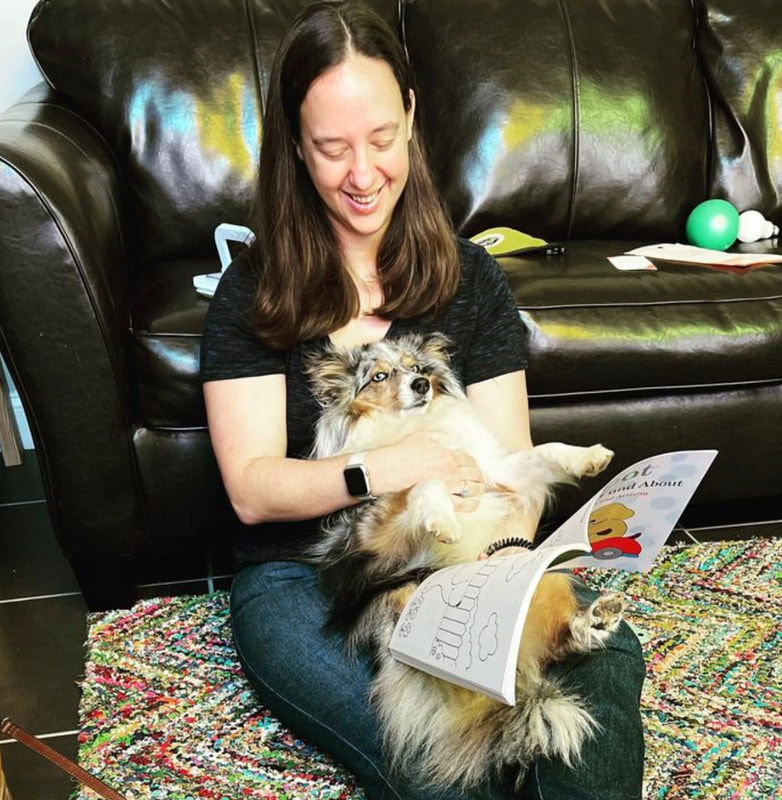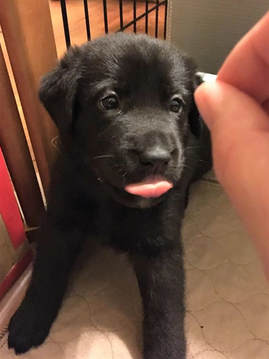I have been using positive reinforcement for more than 13 years to teach dogs of all ages from 2 weeks old to 16 years old; and has been equally effective whether my clients are teaching puppies house manners like sitting at doors, or teaching dogs not to bark in the crate or be destructive in the house; or training precision sports such as agility and flyball, or even rigorous competition obedience and service dog training. So what exactly is positive reinforcement and how does it work? Positive reinforcement is one of the most effective ways in which all animals – dogs, humans, cats, lab rats, even single-celled organisms – learn behaviors. Positive reinforcement means that when the animal does a behavior and receives something pleasurable in return, he is likely to try to repeat that behavior again. Examples of positive reinforcement abound: You smile at a stranger in the store and he reinforces you by smiling back; you will be more likely to smile at him again. Your cat is affectionate to you in the kitchen and you reinforce her by letting her lick the can of tuna; she is likely to act affectionately to you again next time you open a can. Your dog brings you a toy and you reinforce him by playing a fun game of tug with it; he is likely to bring a toy to you in the future. Think about all the activities you do in a day: shower, get dressed, make coffee, go to work, come home, cook dinner, watch tv, go to bed, and so many more in between. How many of these behaviors have some sort of reinforcement value to you which helps ensure that you will do those behaviors again in the future? It is easy to see how positive reinforcement can apply to dog training: you ask your dog to sit and reward him with a treat when he does; he is more likely to sit again next time you ask him to. Positive reinforcement training is a fun and simple way to teach dogs tricks, and many of our pet dogs can show off a couple of tricks. But dog owners also know that living with a dog involves so much more than teaching tricks. How can we use positive reinforcement to teach dogs to stop acting up and to behave? First, it’s important to understand that rewards don’t only come from you, rewards for your dog can come from anywhere in the environment. A puppy chews on the sofa and realizes that it feels soft and squishy and good in his mouth; he’s likely to chew on the sofa again. An adolescent dog is excited to see you when you come home from work, and in all that excitement he jumps on you when you walk in the door; the energy release of jumping and running around feels good to him and he’s likely to jump next time he feels particularly energetic. An adult dog notices you’re gone from the house and gets on your bed for a nap; your bed is comfortable so he’s likely to try to sleep on it again next time he needs a nap. The first crucial step in training, then, is to manage your dog’s environment so that he doesn’t inadvertently get rewarded for behaviors that you don’t want him to learn to do. The puppy, for example, won’t learn to chew on the sofa if he never has the opportunity to chew on the sofa. Your first objective in training is to prevent the unwanted behavior from happening in the first place. When you’re home with your puppy, keep an eye on him; if he begins to look interested in chewing on the sofa, redirect his attention to a different activity so he doesn’t have the chance to discover the supreme joy of sofa-chewing. And when you’re not home or when you can’t supervise your puppy, make sure he’s in a safe place like a crate or a puppy-proofed room, where puppy does not have the chance to do any of those unwanted behaviors. Puppy-proofing and managing the environment are important, but the important next step is to teach your dog what behaviors TO do. Any time you find yourself telling a dog “don’t do that behavior,” your dog needs to know to “do this behavior instead.” This is where effective, positive-reinforcement based training comes in to play! Take, for example, the adolescent dog who jumps on your nice clothes when you come home from work because he is so excited to see you. You can first manage his environment: have him in a crate when you walk in the house so he calms down before you greet him. You’re effectively using your management to communicate “don’t jump on me,” but what is the dog supposed to do instead of jumping? If we teach the dog to sit even when he’s very excited and there are a lot of distractions, you can ask him to sit as soon as you walk in the door; then you can reinforce that sit by giving him attention, which is the most important thing on his mind at that moment anyway. We could also teach him that your walking in the door is a cue to find a toy; if he’s thinking about bringing you a toy he will be less likely to think about jumping on you. One other significant thought about problem behaviors is to consider medical issues. Especially with adult dogs, whenever a new problem behavior pops up, it is a good idea to rule out medical causes. For example, the adult dog who lays on your bed when you’re not home may be developing arthritis or another medical condition that makes it particularly uncomfortable to lay on the floor or on his bed. Medical conditions can cause a plethora of behavior problems, including hyperactivity, restlessness, chewing, aggression, potty accidents, not wanting to train, not wanting to eat treats, etc. It is important to take your dog to the vet regularly just to rule out medical conditions and make sure he’s comfortable and healthy. Positive reinforcement is a training methodology that sounds simple but can actually be quite complex and nuanced. When done correctly, though, you will not only teach your dog house manners and obedience, but you will have a strong and lasting relationship built on trust and effective communication. So think about it: how can you use positive reinforcement techniques to train your dog today?
2 Comments
Thanks Elizabeth for a great overview. We often personalize the self rewarding behaviors that dogs display as a lack of affection for us. In the understanding that these behaviors are natural and rewarding for the dog and nothing to do with whether they "love" us or not, we can assist them in finding more acceptable ways to release the energy associated with these behaviors. I especially like the thinking that training is not about obedience only, it is about building a trusting and lasting relationship. The desired behaviors that we expect from our canine companions are much more likely to be longer lasting if we build them from a strong and respectful relationship. Trust comes more readily from positive reinforcement versus negative reinforcement or punishment. Thanks again for your insights.
Reply
Elizabeth Morgan
1/30/2018 12:25:32 pm
You’re so right, Joe! So often owners and trainers alike can fall into thinking that punishing a behavior should work quickly and be ok, but unfortunately there are so many side-effects to punishment that one simple behavior could damage the relationship between the dog and his owner, causing more problems in the long run. Positive reinforcement training requires consideration and planning, but with some practice, the dog and owner both will be happier in the long run!
Reply
Leave a Reply. |
AuthorElizabeth Morgan specializes in training service dogs as the trainer and owner of Alabama Dog Academy. Archives
January 2024
Categories |
|
256-434-1747 (call or text)
[email protected] |
Proudly powered by Weebly




 RSS Feed
RSS Feed


